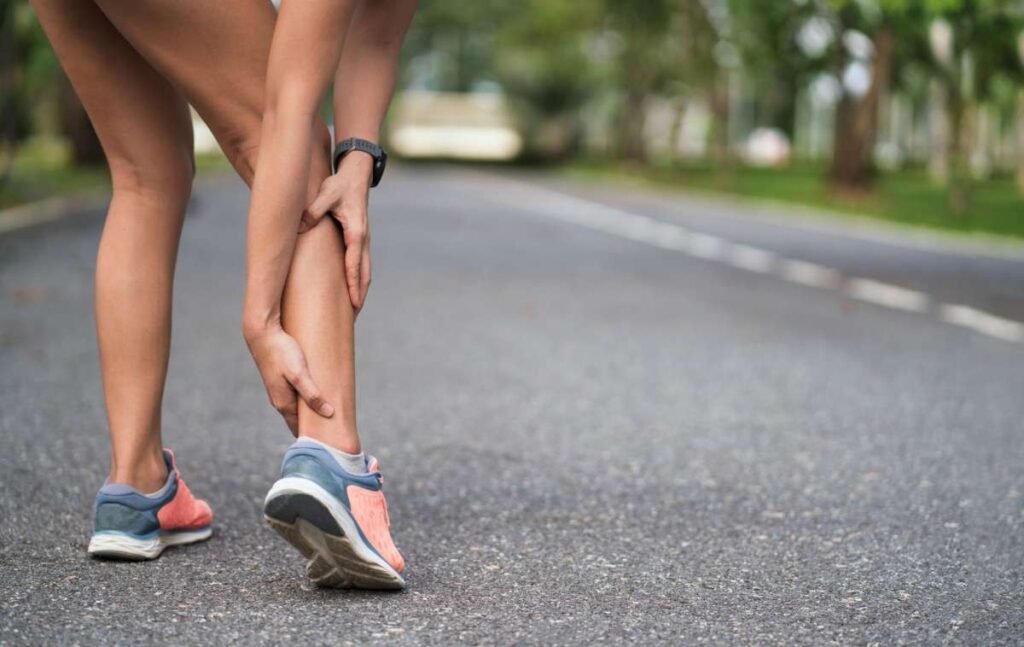
A calf strain affects the muscles at the back of the lower leg, and tends to come about due to a sudden excessive force through the muscle, or with repetitive overuse.
The calf is a group of muscles that allow you to point your foot and your toes downwards, generating the propulsive forces that help you to walk, run and jump. There are 7 muscles in total with the largest ones being the gastrocnemius and the soleus. These big muscles generate the greatest force. Any one of these muscles can suffer a strain.
Once injured, bruising and/or swelling may appear in the calf. This is due to the injury within the tissues. You may also experience pain, particularly when walking or performing any activity that uses the affected muscles. You may be aware of stiffness within these tissues, particularly after periods of rest. The severity of your injury will dictate how long it will take you to recover. This can range from 1 week to 6 weeks or more, depending on how strict you are with your post-injury care routine. With the correct management, your injury should settle back to normal.
Muscles have a large blood supply which tends to mean an injury to these tissues will resolve in good time.
Help your body to recover by elevating your leg for short periods in the early phase. This will help any swelling and bruising to disperse. Ice can be an excellent additional aid in settling any bruising and/or swelling. Be sure to wrap your ice in a damp cloth and monitor your skin to avoid ice burns.
After the initial injury it may be wise to reduce the amount of walking you do, and any other activities that use these muscles such as running and jumping. Go for non weight bearing activities instead to keep you fit and active, such as cycling and swimming. To help with the recovery and the uncomfortable symptoms you are experiencing, it may be advised to perform small circles and ankle pumps now and then to avoid stiffness. This will also help your body to keep the blood pumping around your tissues.
You may be assessed to try and establish why the injury occurred in the first place. Perhaps you are weak elsewhere and so overuse your calf muscles as a consequence, or perhaps you need better structure to your activity regime. You will likely be given some exercises to help you to recover fully from your injury. These may include stretches to address any tight areas in your leg, and strength exercises to get you back up to your usual level of fitness. Whatever the reason for your injury, be sure not to rush your rehab. With patience and the correct guidance you’ll be back to doing what you love most.
EXERCISE TIPS
TREATMENT PLAN
Here at Don Kelly Physiotherapy and Acupuncture clinic we have treated this very common condition very successfully in both our Limerick and Charleville clinics.
Phyio exercises and acupressure: This can be an ancient type of treatment that is comparable to acupuncture, but does not use needles. It applies pressure to particular pressure points which encourages blood circulation, relieves muscle tension, and triggers our body natural healing :
I have treated my patients with a 100% success rate. Armed with experience in the last 20 years of providing my physiotherapy services in Limerick and Charleville.
If you experience chronic pain, injuries, or advice for knee surgery and replacement please don’t hesitate to reach out. I have treated thousands of my patients with successful results over the last 20 years of my physio services.
BEFORE YOU SAY YES TO KNEE SURGERY REPLACEMENT– give me a ring for an assessment.
My treatment plan is the result of my experience and knowledge in treating chronic pains and injuries over the last 20 years. This is the holistic plan to guarantee pain relief, prevent recurring pains, and faster recovery.


